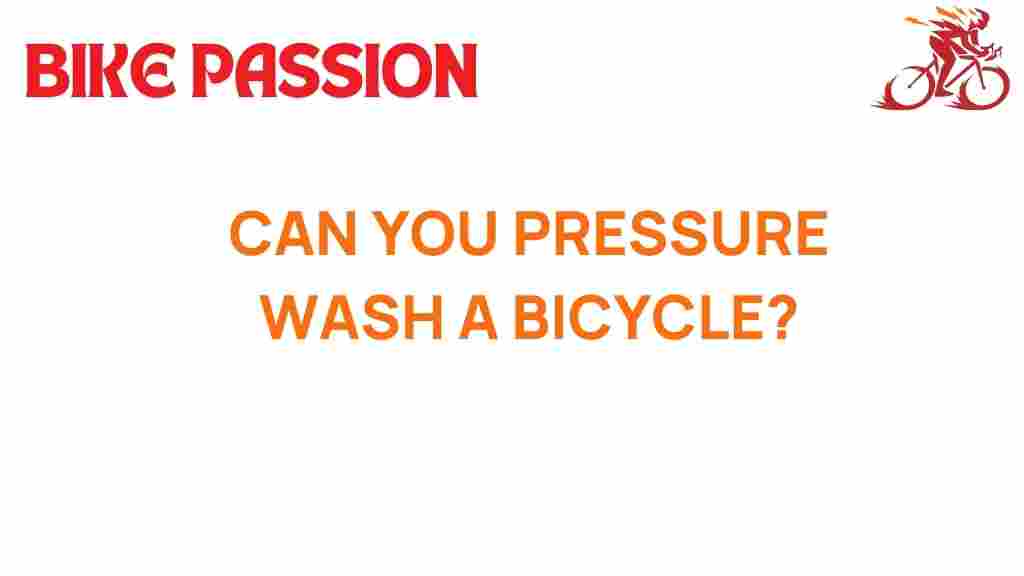The Hidden Risks: Is Pressure Washing Your Bicycle a Good Idea?
When it comes to keeping your bicycle in top shape, regular maintenance is key. One method that many cyclists consider for cleaning their bikes is pressure washing. While it can seem like a quick and effective solution to remove dirt and grime, pressure washing your bicycle can come with hidden risks. In this article, we will explore the implications of using pressure washing as a cleaning method, along with essential bicycle maintenance tips to keep your cycling gear in pristine condition.
Understanding Pressure Washing
Pressure washing involves the use of a high-pressure water spray to clean surfaces. It’s commonly used for outdoor cleaning tasks, such as washing decks, driveways, and vehicles. However, when it comes to bicycle maintenance, the question arises: is pressure washing a good idea?
Potential Risks of Pressure Washing Your Bicycle
While pressure washing can effectively remove dirt and debris, it poses several risks specific to bicycles:
- Damage to Components: High-pressure water can force its way into bearings, seals, and electronic components, leading to premature wear or failure.
- Water Intrusion: Many bike parts, like hubs and bottom brackets, are not designed to withstand high-pressure water. This can lead to water damage and rust.
- Removal of Lubricants: Pressure washing can strip away essential lubricants from chains and gears, affecting bike performance and safety.
- Risk of Scratches: If not done correctly, the high-pressure spray can scratch delicate surfaces, including painted finishes or decals.
Alternatives to Pressure Washing
Instead of resorting to pressure washing, consider these safer alternatives for bike cleaning:
- DIY Cleaning: Use a bucket of warm soapy water and a soft sponge or cloth to clean your bike.
- Bike-Specific Cleaners: Invest in products designed specifically for bike cleaning, which are less likely to harm your equipment.
- Gentle Hose Spray: If you need to rinse your bike, use a gentle spray from a garden hose, avoiding high pressure.
Step-by-Step Guide to Safe Bike Cleaning
Here’s a step-by-step process for safely cleaning your bicycle without the risks associated with pressure washing:
- Gather Your Supplies: You’ll need a bucket, bike cleaner, sponge, soft brushes, and a hose.
- Prepare Your Bike: Shift the gears to ensure that the chain is well-positioned for cleaning. Remove any accessories that may get in the way.
- Apply Cleaner: Mix the bike cleaner with water in the bucket. Use a sponge or soft brush to apply the solution to your bike, focusing on areas with dirt buildup.
- Rinse Gently: Use a gentle stream of water from a hose to rinse off the cleaner. Avoid using a pressure washer.
- Dry the Bike: Use a clean, dry cloth to wipe down your bike to prevent water spots and rust.
- Lubricate Moving Parts: After cleaning, apply lubricant to the chain, derailleurs, and other moving parts to keep them functioning smoothly.
Maintenance Tips for Keeping Your Bicycle in Top Shape
Regular maintenance is crucial for ensuring the longevity and safety of your bike. Here are some essential maintenance tips:
- Regular Inspections: Check your bike for any signs of wear and tear, including tire pressure, brake function, and gear shifting.
- Keep It Clean: Clean your bike after every ride, especially if you’ve been in wet or muddy conditions.
- Store It Properly: Keep your bike in a dry, sheltered place to prevent rust and damage from the elements.
- Schedule Professional Tune-Ups: Take your bike to a professional for a tune-up at least once a year.
Troubleshooting Common Bike Cleaning Issues
Even with the best intentions, you may encounter issues while cleaning your bike. Here are some common problems and solutions:
- Stubborn Dirt: If dirt is caked on, let the cleaner sit for a few minutes before scrubbing. This will loosen the grime.
- Chain Making Noise: If your chain is noisy after cleaning, it may need more lubrication. Apply a bike-specific lubricant and wipe off any excess.
- Brake Performance Issues: If your brakes feel spongy after cleaning, check for water intrusion and dry the brake components thoroughly.
Conclusion
Pressure washing might seem like an easy solution for bike cleaning, but the potential risks far outweigh the benefits. Instead, opt for safer, more effective methods to maintain your bicycle. Regular cleaning, proper storage, and diligent maintenance are critical components of bike care that contribute to both performance and safety.
Remember, your bicycle is an investment in your health and enjoyment, and it deserves the best care possible. For more tips on bike maintenance and safety, check out our resource page.
Ultimately, by prioritizing safe cleaning methods and routine maintenance, you can extend the life of your bicycle and ensure that every ride is enjoyable and safe.
This article is in the category Maintenance and created by BikePassion Team
